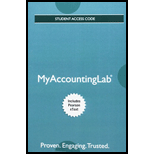
Concept explainers
Introduction:
Capital Budgeting: Capital budgeting is a technique to make decisions for investment of the capital of the business. Capital budgeting uses several methods to identify and evaluate projects and helps in making decisions for investment. Capital budgeting has following basic steps:
1. Identification of the opportunities or projects
2. Evaluation of projects
3. Determination of
4. Making decision of investment in the project
5. Implementation of the decisions
To Choose: The Second step of Capital Budgeting
Answer to Problem 1QC
Solution: c. Getting the accountant involved
Explanation of Solution
Explanation for Correct answer:
The Second step of Capital Budgeting is Evaluation of projects or opportunities available, which requires the involvement of the accountant to use estimated data and methods of capital budgeting to determine if the project would be profitable or not.
Explanation for Incorrect answers:
a. Gathering the money for investment is the last step of the capital budgeting when actual implementation of the project is done.
b. identifying potential projects is the first step of the capital budgeting.
d. All the given options are different steps of the capital budgeting.
Hence, the Second step of Capital Budgeting is c. Getting the accountant involved.
Want to see more full solutions like this?
Chapter 26 Solutions
MyLab Accounting with Pearson eText -- Access Card -- for Horngren's Accounting

 AccountingAccountingISBN:9781337272094Author:WARREN, Carl S., Reeve, James M., Duchac, Jonathan E.Publisher:Cengage Learning,
AccountingAccountingISBN:9781337272094Author:WARREN, Carl S., Reeve, James M., Duchac, Jonathan E.Publisher:Cengage Learning, Accounting Information SystemsAccountingISBN:9781337619202Author:Hall, James A.Publisher:Cengage Learning,
Accounting Information SystemsAccountingISBN:9781337619202Author:Hall, James A.Publisher:Cengage Learning, Horngren's Cost Accounting: A Managerial Emphasis...AccountingISBN:9780134475585Author:Srikant M. Datar, Madhav V. RajanPublisher:PEARSON
Horngren's Cost Accounting: A Managerial Emphasis...AccountingISBN:9780134475585Author:Srikant M. Datar, Madhav V. RajanPublisher:PEARSON Intermediate AccountingAccountingISBN:9781259722660Author:J. David Spiceland, Mark W. Nelson, Wayne M ThomasPublisher:McGraw-Hill Education
Intermediate AccountingAccountingISBN:9781259722660Author:J. David Spiceland, Mark W. Nelson, Wayne M ThomasPublisher:McGraw-Hill Education Financial and Managerial AccountingAccountingISBN:9781259726705Author:John J Wild, Ken W. Shaw, Barbara Chiappetta Fundamental Accounting PrinciplesPublisher:McGraw-Hill Education
Financial and Managerial AccountingAccountingISBN:9781259726705Author:John J Wild, Ken W. Shaw, Barbara Chiappetta Fundamental Accounting PrinciplesPublisher:McGraw-Hill Education





